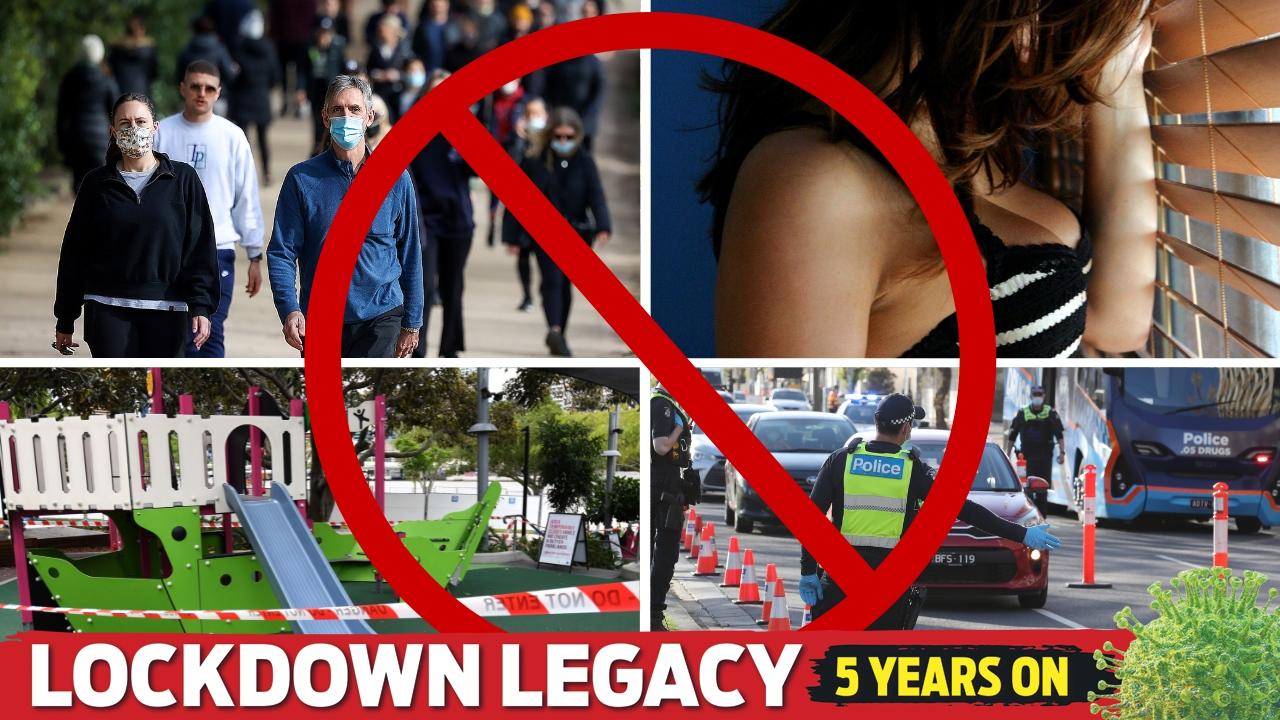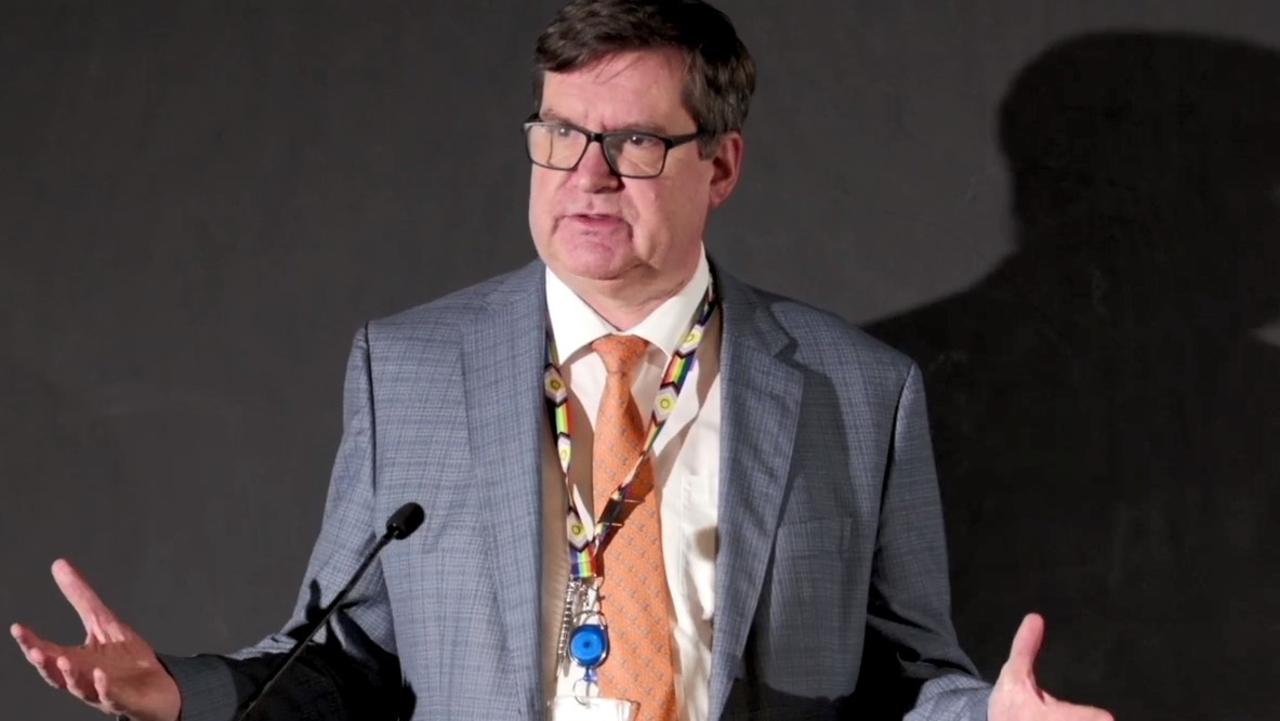Victorian chief health officer Brett Sutton gets jab as vaccination hubs open
Chief Health Officer Brett Sutton has rolled up his sleeve for his COVID-19 vaccination, revealing some serious body art in the process.
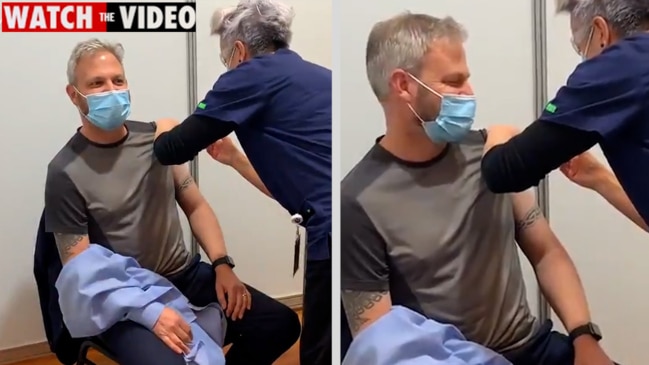
Coronavirus
Don't miss out on the headlines from Coronavirus. Followed categories will be added to My News.
Victoria’s Chief Health Officer Brett Sutton has flashed his tattoos while receiving the AstraZeneca jab.
Professor Sutton was one of the first patients to arrive at one of Victoria’s mass COVID-19 vaccination centres – the Royal Exhibition Building – for their AstraZeneca vaccine as authorities move to speed up the delayed rollout.
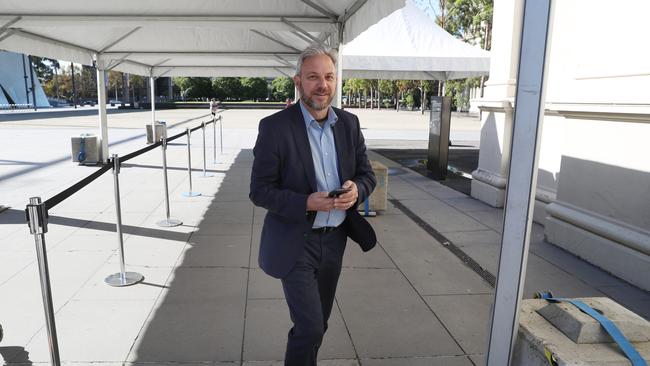
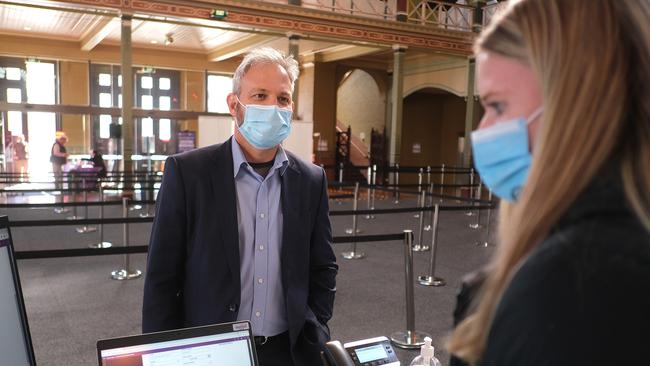
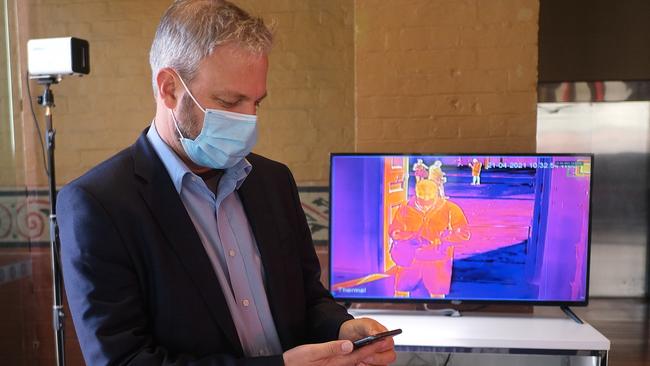
The Royal Exhibition Building in Carlton Gardens opened to Victorians aged 70 and older, or who have a medical condition or disability that places them in the phase 1b group.
A small group of anti-vax protestors were moved on from outside the building.
The Herald Sun observed a member of the group scream an obscenity before walking away.
A witness, who didn’t want to be named, said it was upsetting they were disturbing elderly people just trying to queue up for their vaccine.
Everyone who entered was asked by staff to check in using the displayed QR code and don a mask before heading inside, with a small but steady stream of people turning up.
Numbers were small enough about 10am that the marquees — set up in front of the building to shelter those who needed to queue outside — had not been used yet.
Police officers and firefighters were also spotted queuing up, with emergency services personnel among the workers included in phase 1b of the rollout.
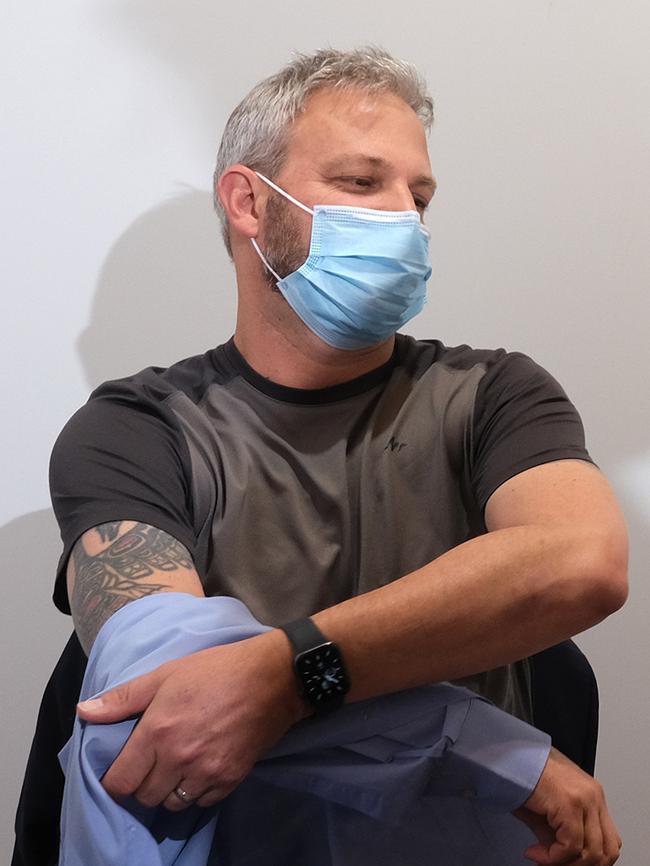
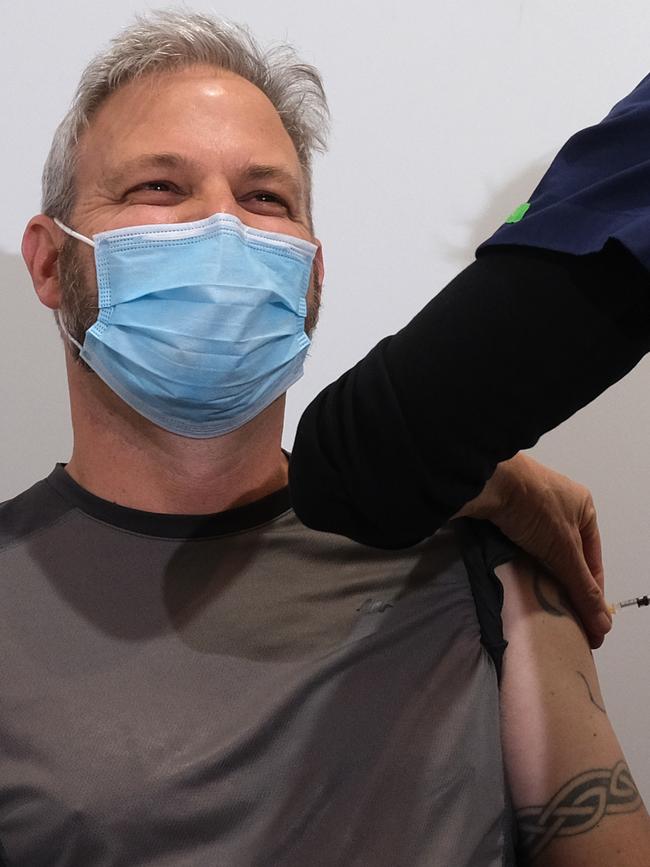
But the most high-profile of workers due to get vaccinated was Prof Sutton, who said he was “delighted” to receive the jab.
Prof Sutton also moved to allay any fears about complications from the AstraZeneca vaccine.
“Our health services have worked hard to deliver the AstraZeneca vaccine to the highest safety standards,” he wrote.
“The risk of really serious adverse events is rare, which is why I’m getting my vaccination. The best vaccine to get is the one available right now.”
Prof Sutton said while the Pfizer jab was recommended for under-50s, AstraZeneca would still be available for younger Australians who wanted it.
“For over 50s, it’s either vaccine and obviously the AstraZeneca vaccine is the one that is available in pretty good numbers at the moment,” he told 3AW Breakfast on Wednesday morning.
“It’s about the risk-benefit. The risk of serious illness (from COVID-19) is lower, the younger you get.”
Don’t know what you call a selfie post-vaccine. But here’s my #vaxxie and couldn’t be happier. Caring, professional and efficient approach of everyone at the Royal Exhibition Buildings, especially the â¦@StVincentsMelbâ© staff. Thank you! pic.twitter.com/gmAKMDeuI8
— Chief Health Officer, Victoria (@VictorianCHO) April 21, 2021
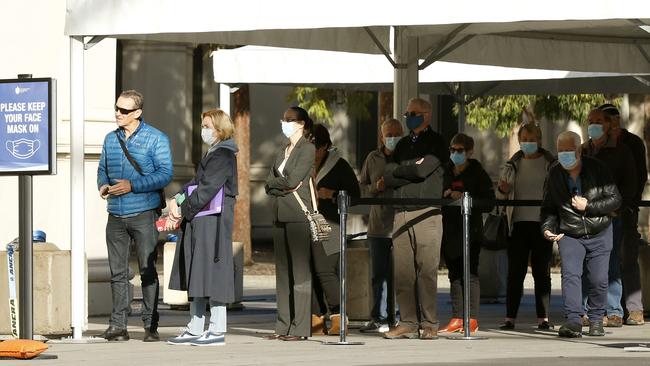
Fitzroy North couple Magdaline and Samir Michail — each sporting a blue COVID-19 vaccine sticker — were among the first patients to get their vaccine at the Royal Exhibition Building today.
Mrs Michail, 76, joked that they felt great “but we’ll see how we’ll feel later”.
Joking aside, the couple said it was the advice of their son, a doctor, that convinced them to listen to the medical evidence showing the AstraZeneca vaccine is their safest option by far.
“We were hesitant, we have to choose between having coronavirus or having the blood clot,” Mr Michail said.
“But the risk is very small and our son is a doctor and he was insisting we get it as soon as we can.”
The couple, who have been married for 53 years, said they would still be cautious while they wait for the jab to take effect.
“All the time we’re going outside with masks and we keep quiet,” he said.
The couple’s son’s insistence it was safer for them to get the vaccine is backed by the medical advice.
For every one million people who get the vaccine, four to six people have had a vaccine-linked blood clot.
For every one million people who get COVID-19, the risk of severe illness — including blood clots — is higher.
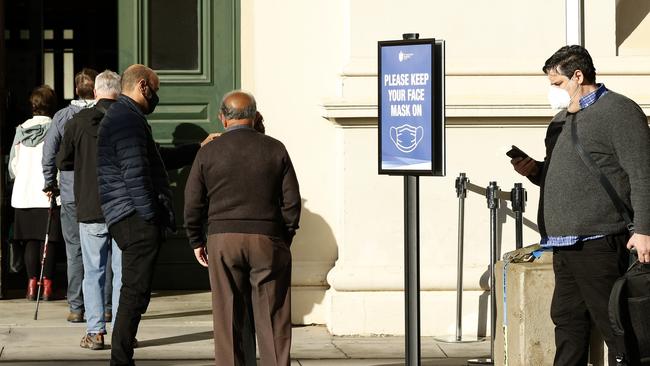
Steve Bassili, who got his first vaccine today, urged everyone who’s eligible to get their shot.
The 71-year old said it was surprising “how empty it was”.
“It’s shocking, really, I’m surprised people are not interested in taking that first step (and getting the shot).
He said the fear over blood clots was exaggerated and getting the vaccine was the right thing to do so the community and Australia could “move forward”.
“Do it for your country,” he said.
“The media should strongly advertise (the Royal Exhibition Building) is open and it is safe.
“I spoke to my GP and he said the risk of not having it is higher than the risk of having it.
“It’s a one in a million (chance), I can walk out of the centre vaccinated and get hit by a car.”
The Egyptian-Australian has seen the damage COVID can do, with a family member overseas catching the virus.
“My niece’s husband was hit with COVID (and) had to go to hospital,” he said.
“He was younger than me.
“(Overseas) it was a tragedy.”
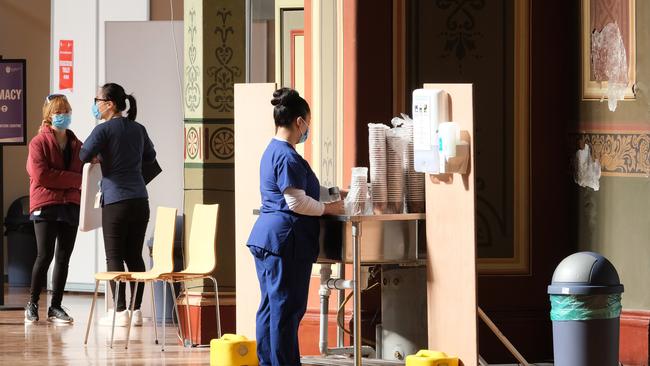
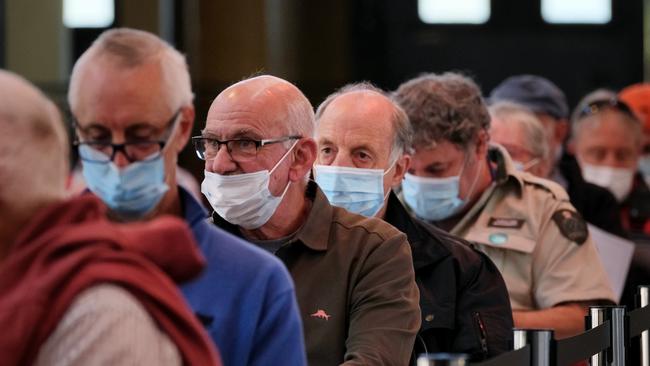
Steve Edwards said he went with his wife, Leigh, who is eligible for the jab under phase 1B, to the Carlton Gardens hub this morning.
But the 69-year old told the Herald Sun he was let in and given a dose despite being a year off the eligible age.
“I’m not quite 70 but they let me in,” he said.
His wife Leigh, 61, said she was “relieved” to get the shot but hopes more people turn up.
“It was pretty good ... very streamlined (and) not crowded,” she said.
“It would be nice to see more people.”
She said some of the press coverage of the very small blood clot risk posed by AstraZeneca was sensational and believes it has impacted turnout today.
“It’s frightening people, as indicative here,” she said.
“I think the media outlets should do a bit more to reassure people.”
She said she chose to get the jab after talking to her doctor.
“I spoke to the GP to clarify a few concerns and he said overwhelmingly I should have it,” he said.
Her husband agreed and said the risk was “tiny”.
“It’s much better to go have it (the AstraZeneca vaccine) than COVID,” he said.
Anthony Copley, 77, said he came to the centre after hearing about it on the news on Tuesday night.
“It was very easy, not many people lined up and (it was) very efficient,” he said.
“My concern is for everybody to get it done so we can move and get on with it,” he said.
But numbers appeared to pick up by early afternoon, with the queues briefly spilling outside the building.
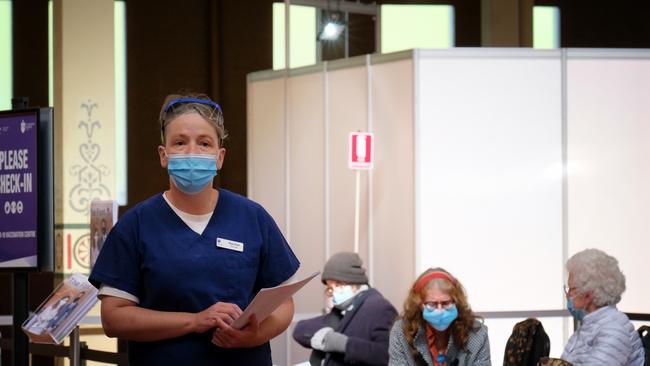
CONFIDENCE INCREASES IN JAB
The number of calls to the jab hotline spiked, particularly from many older Victorians who had expressed interest in getting the AstraZeneca vaccination.
Acting Premier James Merlino said there had been a “good uplift” in calls to the Department, in terms of getting vaccinated.
“I see that as a positive sign. We did take a hit in public confidence in our vaccination program, but we are seeing, particularly with older Victorians, they’re coming forward and being very keen to get vaccinated,” Mr Merlino said.
“That’s why we’ve made the announcement of opening up our three largest vaccination hubs. This is one way we can expedite the vaccine rollout, as quickly as possible, particularly to our most vulnerable.”
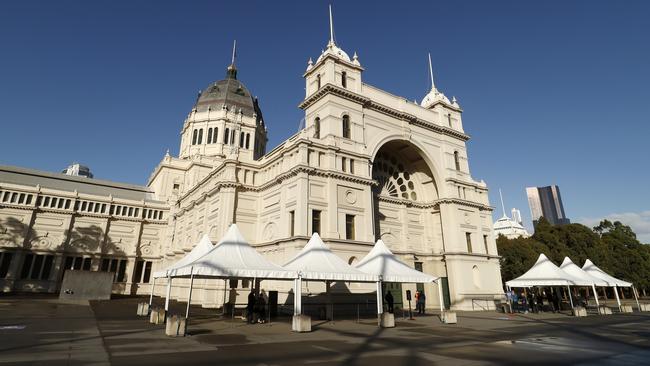
People in phases 1a and 1b of the vaccine rollout can attend a mass vaccination hub from Wednesday.
The high-volume centres will deliver the AstraZeneca vaccine, but people under the age of 50 can elect to receive a Pfizer vaccine.
For example, a 35-year-old healthcare worker can receive the Pfizer vaccine but should book in advance to secure the in-demand jabs.
Testing commander Jeroen Weimar said he was confident the AstraZeneca was safe, particularly for those over the age of 50, despite recent concerns around clotting.
“I get the fact that people are concerned. I get why people would feel ‘what’s the rush’. Let’s be very clear – we’ve seen 3 million deaths from COVID around the world, we’ve got very active COVID outbreaks in Papua New Guinea,” he said.
“We’ll only get out of this when we all get vaccinated. I don’t want people to rush there at 9am tomorrow and wait all day but we do encourage people to come forward and get their vaccine.”
Those eligible for the jab include quarantine and border workers, frontline health care workers, aged care and disability staff, and aged care and disability residents.
Household contacts of quarantine and border workers, critical and high risk workers (including emergency services and meat processing), elderly people over 70, Aboriginal and Torres Strait Island people over 55, and adults with underlying medical conditions or significant disability can also get vaccinated.
Mr Merlino said the rollout of the high-volume vaccination hubs was dependent on supply from the Commonwealth.
“It all comes down to supply. We can, and we are willing and able to do more,” he said.
Discussions at national cabinet on Monday included how the states can “recalibrate” the program to ensure vaccines could be distributed to vulnerable cohorts “as quickly as possible”.

$50M BOOST FOR VIC VAX PRODUCTION
The Victorian government also announced a $50 million boost towards new technology and research to produce a locally made COVID-19 vaccine.
Acting premier James Merlino and health minister Martin Foley announced the program from Monash Children’s Hospital on Wednesday morning.
It will take at least 12 months to build the vaccine.
“We don’t know what the future holds. We may well need booster vaccines,” Mr Merlino said.
mRNA vaccines have been dubbed a “promising alternative” to traditional vaccines because of their high efficacy, capacity for rapid development, low-cost manufacture and safe administration.
“This is a great vaccine,” Mr Merlino said.
Victoria is ideally placed to lead in mRNA manufacturing and the production of mRNA vaccines and therapeutics.
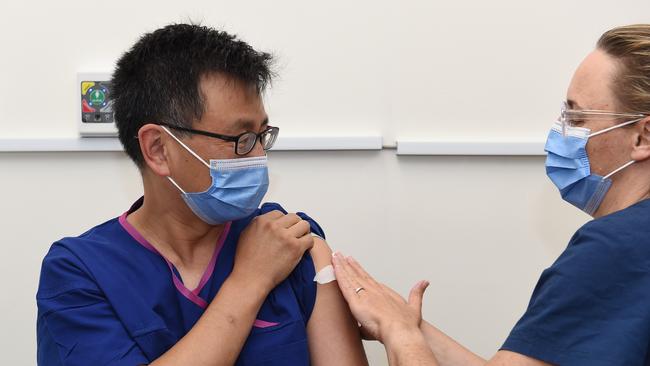
The state government will work alongside the federal government and world leading experts from Monash University, the University of Melbourne, the Doherty Institute and other leading research institutes to develop the first mRNA manufacturing capability in the Southern Hemisphere.
The location will be identified through a partnership between government, universities and research parties. It will be based in Melbourne but the location is yet to be determined.
Acting Premier James Merlino said: “It’s vital that we can develop and manufacture mRNA vaccines and treatments locally to ensure we have vaccine security here in Australia and across our region.”
MRNA vaccines teach our cells how to make a protein — or even just a piece of a protein — that triggers an immune response inside our bodies.
The Pfizer and Moderna vaccines – which are manufactured in Europe and the United States – are forms of mRNA.
“This is an exciting day for Victoria … This technology is the way of the future,” health minister Martin Foley said.



